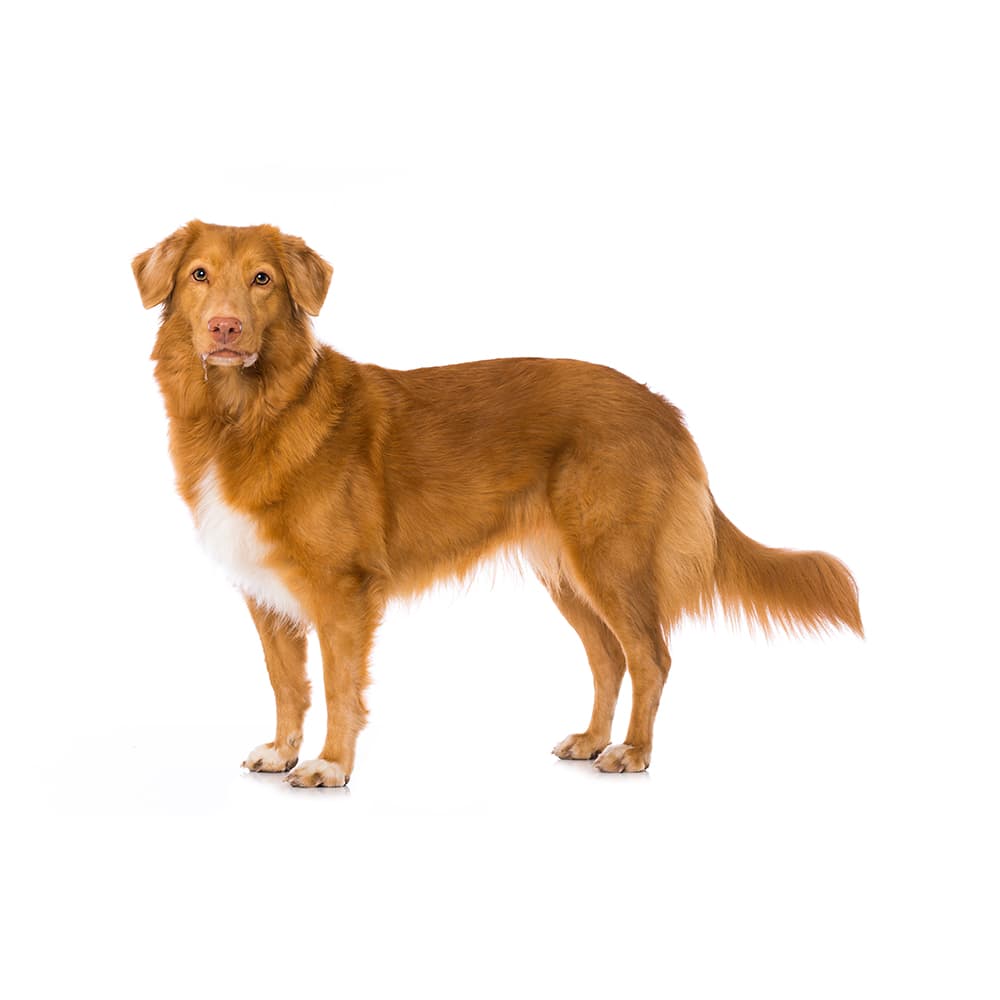Discover your dog's connection to this breed and 200+ others


Discover your dog's connection to this breed and 200+ others



The Nova Scotia Duck Tolling Retriever, also known as the Toller, Duck Toller, or Little River Duck Dog, is a medium-sized breed of gundog bred primarily for hunting. It is the smallest of the retrievers and is often mistaken for a small Golden Retriever. The breed originated in Yarmouth County, in southwestern Nova Scotia, Canada, during the early 19th century. The breed was developed to toll, lure, and retrieve waterfowl. Tolling means to lure game to approach within shooting range, and it involves the dog playing along the shoreline in full view of a flock of ducks, piquing their curiosity so that they swim over to the shore and within gunshot range. The Toller's coat is perfect for water-related activities, as it is dense and water-repellent, made up of a short, soft undercoat and a long, harsh outer coat.
Nova Scotia Duck Tolling Retrievers can suffer from hip dysplasia, autoimmune issues, and progressive retinal atrophy. A specific genetic condition from which this breed may suffer is Addison’s disease, and is known to occur in puppies. Other conditions that affect this breed include cleft lip/palate and syndactyly (CLPS), hyperuricosuria, degenerative myelopathy, chondrodystrophy and intervertebral disc disease (CDDY and IVDD risk) with or without chondrodysplasia (CDPA), and Collie eye anomaly.
Tollers are known for their intelligence, adaptability, and energy. They have a strong retrieving drive and love to play, making them excellent companions for active families that love to hike, camp, swim, and more. These dogs are not for those who prefer a quiet, less active routine. Their intelligent and eager-to-please nature also makes them very trainable. However, they can be somewhat reserved around strangers, so socialization at an early age is important.
A canine genetic lineage is a group of individuals or entire breeds that descended from common ancestors predating modern breed formation. Often these lineages are associated with a ‘type’ of dog with a unique historical working role and associated behaviors (e.g., herding, scent hunting, etc.).
A canine genetic lineage is a group of individuals or entire breeds that descended from common ancestors predating modern breed formation. Often these lineages are associated with a ‘type’ of dog with a unique historical working role and associated behaviors (e.g., herding, scent hunting, etc.).
Breeds within the retriever lineage were bred to retrieve game for their hunter. These breeds can locate game that has been shot near water or in dense brush and bring it back without damaging it. Retrievers have strong swimming abilities, are intelligent, eager to please and highly trainable which makes them excellent hunting companions. Retrievers are also friendly, and sociable with high energy levels.
Example breeds with ancestry from this lineage include Golden Retriever, Labrador Retriever, and Chesapeake Bay Retriever.
The "tolling" behavior exhibited by this breed is said to mimic the playful antics of a fox, which helps to attract curious waterfowl within shooting range. The word "toller" comes from the Middle English "tollen", which means "to entice".
Although not as well-known as other retriever breeds, the Nova Scotia Duck Tolling Retriever is the official dog breed of its namesake Canadian province, Nova Scotia.
While they were bred for hunting, Tollers also excel in various dog sports, including obedience, agility, and flyball.
https://www.petmd.com/dog/breeds/c_dg_nova_scotia_retriever https://www.pawprintgenetics.com/products/breeds/79/ https://www.pawprintgenetics.com/products/tests/details/87/?breed=79 https://vgl.ucdavis.edu/breed/nova-scotia-duck-tolling-retriever
https://www.akc.org/dog-breeds/nova-scotia-duck-tolling-retriever/ https://www.ukcdogs.com/nova-scotia-duck-tolling-retriever
https://www.fci.be/en/nomenclature/NOVA-SCOTIA-DUCK-TOLLING-RETRIEVER-312.html
Recommended by top vets with decades of experience
21 breeds
64 genetic health markers
50 genetic trait markers
